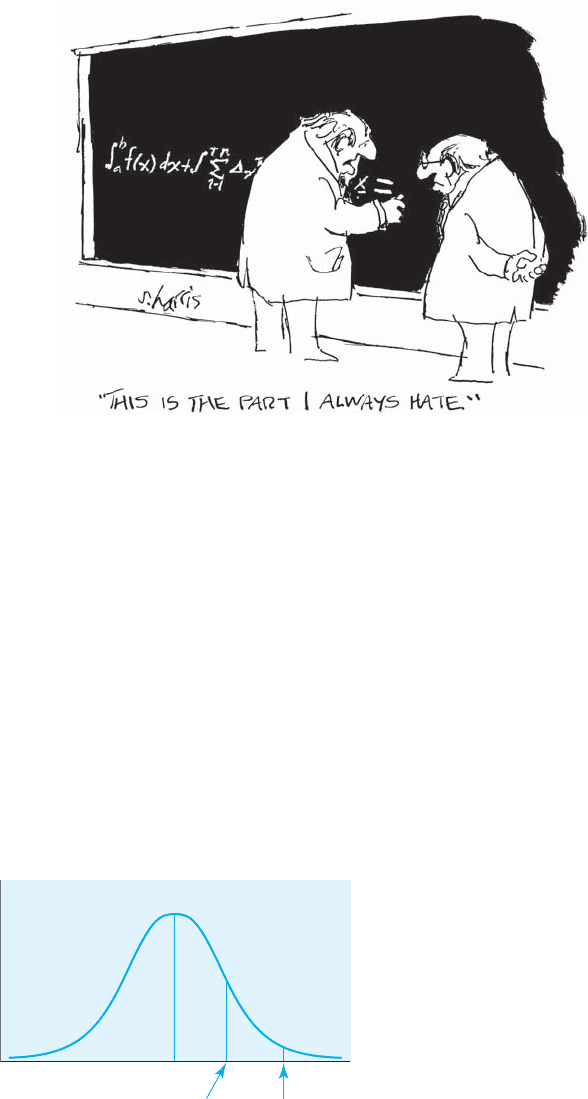Jackson S.L. Research Methods and Statistics: A Critical Thinking Approach
Подождите немного. Документ загружается.


222
■ ■
CHAPTER 8
For hands-on experience using the research meth-
ods described in this chapter, see Chapter 4 “Two-
Group Experiments” in Research Methods Laboratory
Manual for Psychology, 2nd ed., by William Langston
(Wadsworth, 2005), or Lab 9: “Two-Group Designs”
in Doing Research: A Lab Manual for Psychology, by
Jane F. Gaultney (Wadsworth, 2007).
LAB RESOURCES
CHAPTER 8 SUMMARY AND REVIEW: THE LOGIC OF EXPERIMENTAL DESIGN
Several factors need to be considered when design-
ing and evaluating a true experiment. First, the
issues of control and possible confounds need to
be addressed. The study needs to be designed with
strong control and no confounds to maximize internal
validity. Second, external validity needs to be consid-
ered to ensure that the study is as generalizable as
possible while maintaining control. Lastly, the design
most appropriate for the type of research being con-
ducted must be used. Researchers should consider
the strengths and weaknesses of each of the three
types of designs (between-, within-, and matched-
participants) when determining which would be best
for their study.
Chapter 8
■
Study Guide
CHAPTER EIGHT REVIEW EXERCISES
(Answers to exercises appear in Appendix C.)
FILL-IN SELF TEST
Answer the following questions. If you have trouble
answering any of the questions, restudy the relevant
material before going on to the multiple-choice self
test.
1. An experiment in which different participants are
assigned to each group is a
.
2. When we use
, we determine
who serves in each group in an experiment ran-
domly.
3. When the dependent variable is measured both
before and after manipulation of the independent
variable, we are using a
design.
4. is the extent to which the results
of an experiment can be attributed to the manipu-
lation of the independent variable, rather than to
some confounding variable.
5. A(n)
is a threat to internal valid-
ity where the possibility of naturally occurring
changes within the participants is responsible for
the observed results.
6. If there is a problem with the measuring device,
then there may be a(n)
effect.
7. If participants talk to each other about an experi-
ment, then there may be
.
8. When neither the experimenter nor the par-
ticipant know the condition to which each par-
ticipant has been assigned, a
experiment is being used.
10017_08_ch8_p202-224.indd 222 2/1/08 1:26:56 PM

The Logic of Experimental Design
■ ■
223
MULTIPLE-CHOICE SELF TEST
Select the single best answer for each of the following
questions. If you have trouble answering any of the
questions, restudy the relevant material.
1. Manipulate is to measure as
is to
.
a. independent variable; dependent variable
b. dependent variable; independent variable
c. control group; experimental group
d. experimental group; control group
2. In an experimental study of the effects of stress on
appetite, stress is the:
a. dependent variable.
b. independent variable.
c. control group.
d. experimental group.
3. In an experimental study of the effects of stress
on appetite, participants are randomly assigned
to either the no stress group or the stress group.
These groups represent the
and the
, respectively.
a. independent variable; dependent variable
b. dependent variable; independent variable
c. control group; experimental group
d. experimental group; control group
4. Within-participants design is to between partici-
pants design as
is to .
a. using different participants in each group;
using the same participants in each group
b. using the same participants in each group;
using different participants in each group
c. matched-participants design; correlated-
groups design
d. experimental group; control group
5. The extent to which the results of an experiment
can be attributed to the manipulation of the
independent variable, rather than to some con-
founding variable refers to:
a. external validity.
b. generalization to populations.
c. internal validity.
d. both b and c.
6. Joann conducted an experiment to test the effec-
tiveness of an anti-anxiety program. The experi-
ment took place over a 1-month time period.
Participants in the control group and the experi-
mental group (those who participated in the anti-
anxiety program) recorded their anxiety levels
several times each day. Joann was unaware that
midterm exams also happened to take place dur-
ing the 1-month time period of her experiment.
Joann’s experiment is now confounded by:
a. a maturation effect.
b. a history effect.
c. regression to the mean.
d. a mortality effect.
7. Joe scored very low on the SAT the first time
that he took it. Based on the confound of
, if Joe were to retake the SAT, his score
should .
a. instrumentation; increase
b. instrumentation; decrease
c. regression to the mean; increase
d. regression to the mean; decrease
8. When the confound of mortality occurs:
a. participants are lost equally from both the
experimental and control groups.
b. participants die as a result of participating in
the experiment.
c. participants boycott the experiment.
d. participants are lost differentially from the
experimental and control groups.
9. When the measuring device is limited in such a
way that scores at the top of the scale cannot be
differentiated, there is a
effect.
10. The extent to which the results of an experiment
can be generalized is called .
11. When a study is based on another study but
uses different methods, a different manipula-
tion, or a different measure, we are conducting a
replication.
12. If the order of conditions affects the results
in a within-participants design, then there are
.
10017_08_ch8_p202-224.indd 223 2/1/08 1:26:56 PM

224
■ ■
CHAPTER 8
9. Controlling participant effects is to controlling
experimenter effects as
is to .
a. fatigue effects; practice effects
b. practice effects; fatigue effects
c. double-blind experiment; single-blind experi-
ment
d. single-blind experiment; double-blind experi-
ment
10. If you were to use a bathroom scale to weigh
mice in an experimental setting, your experiment
would most likely suffer from a:
a. ceiling effect.
b. floor effect.
c. practice effect.
d. fatigue effect.
11. If we were to conduct a replication in which we
increased the number of levels of the independ-
ent variable, we would be using a(n)
replication.
a. exact
b. conceptual
c. exact
d. systematic
12. Most psychology experiments suffer from the
problem because of the type of partici-
pants used.
a. diffusion of treatment problem
b. college sophomore problem
c. regression to the mean problem
d. mortality problem
10017_08_ch8_p202-224.indd 224 2/1/08 1:26:57 PM

225
Inferential Statistics:
Two-Group Designs
9
CHAPTER
Parametric Statistics
t Test for Independent Groups (Samples): What It Is and What It Does
Calculations for the Independent-Groups t Test • Interpreting the t Test • Graphing
the Means • Effect Size: Cohen’s d and r
2
• Confidence Intervals • Assumptions of
the Independent-Groups t Test
t Test for Correlated Groups: What It Is and What It Does
Calculations for the Correlated-Groups t Test • Interpreting the Correlated-Groups
t Test and Graphing the Means • Effect Size: Cohen’s d and r
2
• Confidence
Intervals • Assumptions of the Correlated-Groups t Test
Nonparametric Tests
Wilcoxon Rank-Sum Test: What It Is and What It Does
Calculations for the Wilcoxon Rank-Sum Test • Interpreting the Wilcoxon Rank-Sum
Test • Assumptions of the Wilcoxon Rank-Sum Test
Wilcoxon Matched-Pairs Signed-Ranks T Test: What It Is and What It Does
Calculations for the Wilcoxon Matched-Pairs Signed-Ranks T Test • Interpreting the
Wilcoxon Matched-Pairs Signed-Ranks T Test • Assumptions of the Wilcoxon Matched-
Pairs Signed-Ranks T Test
Chi-Square (
2
) Test of Independence: What It Is and What It Does
Calculations for the
2
Test of Independence • Interpreting the
2
Test of
Independence • Effect Size: Phi Coefficient • Assumptions of the
2
Test of
Independence
Summary
10017_09_ch9_p225-255.indd 225 2/1/08 1:28:41 PM

226
■ ■
CHAPTER 9
Learning Objectives
• Explain when the t test for independent-groups should be used.
• Calculate an independent-groups t test.
• Interpret an independent-groups t test.
• Calculate and interpret Cohen’s d and r
2
.
• Explain the assumptions of the independent-groups t test.
• Explain when the t test for correlated-groups should be used.
• Calculate a correlated-groups t test.
• Interpret a correlated-groups t test.
• Calculate and interpret Cohen’s d and r
2
.
• Explain the assumptions of the correlated-groups t test.
• Explain when nonparametric tests should be used.
• Calculate Wilcoxon’s rank-sum test.
• Interpret Wilcoxon’s rank-sum test.
• Explain the assumptions of the Wilcoxon’s rank-sum test.
• Calculate Wilcoxon’s matched-pairs signed-ranks T test.
• Interpret Wilcoxon’s matched-pairs signed-ranks T test.
• Explain the assumptions of the Wilcoxon’s matched-pairs signed-ranks
T test.
• Calculate the
2
test for independence.
• Interpret the
2
test for independence.
• Explain the assumptions of the
2
test for independence.
I
n this chapter, we will discuss the common types of parametric statistical
analyses used with simple two-group designs. Depending on the type of
data collected and whether a between-participants or a correlated-groups
design is used, the statistic used to analyze the data will vary. We will look at
the typical parametric inferential statistics used to analyze interval-ratio data
for between-participants and correlated-groups designs, and we will exam-
ine the nonparametric statistics used for comparable designs when ordinal
or nominal data have been collected. For the statistics presented in this chap-
ter, the experimental design is similar—a two-group between-participants
or correlated-groups (within-participants or matched-participants) design.
Remember that a matched-participants design is analyzed statistically the
same way as a within-participants design. The inferential statistics discussed
in Chapter 7 compared single samples with populations (z test, t test, and
2
test). The statistics discussed in this chapter are designed to test differ-
ences between two equivalent groups or treatment conditions.
Parametric Statistics
In the simplest version of the two-group design, two samples (representing
two populations) are compared by having one group receive nothing (the
control group) and the second group receive some level of the independent
10017_09_ch9_p225-255.indd 226 2/1/08 1:28:43 PM
Inferential Statistics: Two-Group Designs
■ ■
227
variable (the experimental group). As noted in Chapter 8, it is also possible
to have two experimental groups and no control group. In this case, mem-
bers of each group receive a different level of the independent variable. The
null hypothesis tested in a two-group design using a two-tailed test is that
the populations represented by the two groups do not differ:
H
0
:
1
2
The alternative hypothesis is that we expect differences in performance
between the two populations, but we are unsure which group will perform
better or worse:
H
a
:
1
2
As discussed in Chapter 7, for a one-tailed test, the null hypothesis is either
H
0
:
1
2
or H
0
:
1
2
depending on which alternative hypothesis is being tested:
H
a
:
1
2
or H
a
:
1
2
, respectively.
A significant difference between the two groups (samples representing
populations) depends on the critical value for the statistical test being con-
ducted. As with the statistical tests described in Chapter 7, alpha is typically
set at .05 ( .05).
Remember from Chapter 7 that parametric tests, such as the t test, are
inferential statistical tests designed for sets of data that meet certain require-
ments. The most basic requirement is that the data fit a bell-shaped distribu-
tion. In addition, parametric tests involve data for which certain parameters
are known, such as the mean () and the standard deviation (). Finally,
parametric tests use interval-ratio data.
t Test for Independent Groups (Samples):
What It Is and What It Does
The independent-groups t test is a parametric statistical test that compares
the means of two different samples of participants. It indicates whether the
two samples perform so similarly that we conclude they are likely from the
same population, or whether they perform so differently that we conclude
they represent two different populations.
Imagine, for example, that a researcher wants to study the effects on
exam performance of massed versus spaced study. All participants in the
experiment study the same material for the same amount of time. The dif-
ference between the groups is that one group studies for 6 hours all at once
(massed study), whereas the other group studies for 6 hours broken into
three 2-hour blocks (spaced study). Because the researcher believes that the
spaced study method will lead to better performance, the null and alterna-
tive hypotheses are
H
0
: Spaced study Massed study, or
1
2
H
a
: Spaced study Massed study, or
1
2
independent-groups t test
A parametric inferential test
for comparing sample means
of two independent groups of
scores
independent-groups t test
A parametric inferential test
for comparing sample means
of two independent groups of
scores
10017_09_ch9_p225-255.indd 227 2/1/08 1:28:44 PM

228
■ ■
CHAPTER 9
The 20 participants are chosen by random sampling and assigned to the
groups randomly. Because of the random assignment of participants, we are
confident that there are no major differences between the two groups prior
to the study. The dependent variable is the participants’ scores on a 30-item
test of the material; these scores are listed in Table 9.1.
Notice that the mean score of the spaced-study group (
X
1
22) is higher
than the mean score of the massed-study group (
X
2
16.9). However, we
want to be able to say more than this. We need to statistically analyze the
data to determine whether the observed difference is statistically significant.
As you may recall from Chapter 7, statistical significance indicates that
an observed difference between two descriptive statistics (such as means)
is unlikely to have occurred by chance. For this analysis, we will use an
independent-groups t test.
Calculations for the Independent-Groups t Test. The formula for an
independent-groups t test is
t
obt
X
1
X
2
________
s
X
1
–
X
2
This formula resembles that for the single-sample t test discussed in
Chapter 7. However, rather than comparing a single sample mean to a
population mean, we are comparing two sample means. The denominator
in the equation represents the standard error of the difference between
means—the estimated standard deviation of the sampling distribution of
differences between the means of independent samples in a two-sample
experiment. When conducting an independent-groups t test, we are
standard error of the
difference between
means The standard devia-
tion of the sampling distribution
of differences between the
means of independent samples
in a two-sample experiment.
standard error of the
difference between
means The standard devia-
tion of the sampling distribution
of differences between the
means of independent samples
in a two-sample experiment.
TABLE 9.1 Numbers of Items Answered Correctly by Each
Participant Under Spaced Versus Massed Study Conditions
Using a Between-Participants Design (N 20)
SPACED STUDY MASSED STUDY
23 15
18 20
25 21
22 15
20 14
24 16
21 18
24 19
21 14
22 17
X
1
22
X
2
16.9
10017_09_ch9_p225-255.indd 228 2/1/08 1:28:44 PM
Inferential Statistics: Two-Group Designs
■ ■
229
determining how far the difference between the sample means falls from
the difference between the population means. Based on the null hypoth-
esis, we expect the difference between the population means to be zero. If
the difference between the sample means is large, it will fall in one of the
tails of the distribution (far from the difference between the population
means).
To determine how far the difference between the sample means is from
the difference between the population means, we convert the mean differ-
ences to standard errors. The formula for this conversion is similar to the
formula for the standard error of the mean, introduced in Chapter 7:
s
X
1
X
2
_______
s
1
2
__
n
1
s
2
2
__
n
2
The standard error of the difference between the means does have a logical
meaning. If we took thousands of pairs of samples from these two popula-
tions and found
X
1
X
2
for each pair, those differences between means
would not all be the same. They would form a distribution. The mean of that
distribution would be the difference between the means of the populations
(
1
2
), and its standard deviation would be s
X
1
X
2
.
Putting all of this together, we see that the formula for determining t is
t
obt
X
1
X
2
_________
_______
s
1
2
__
n
1
s
2
2
__
n
2
where
t
obt
value of t obtained
X
1
and
X
2
means for the two groups
s
1
2
and s
2
2
variances of the two groups
n
1
and n
2
number of participants in each of the two groups (we use n
to refer to the subgroups and N to refer to the total number
of people in the study)
Let’s use this formula to determine whether there are any significant differ-
ences between the spaced and massed study groups. We use the formulas for
the mean and variance that we learned in Chapter 5 to do the preliminary
calculations:
X
1
X
1
____
n
1
220
____
10
22
X
2
X
2
____
n
2
169
____
10
16.9
s
1
2
X
1
X
1
2
___________
n
1
1
40
___
9
4.44 s
2
2
X
2
X
2
2
___________
n
2
1
56.9
____
9
6.32
t
X
1
X
2
_________
_______
s
1
2
__
n
1
s
2
2
__
n
2
22 – 16.9
____________
__________
4.44
____
10
6.32
____
10
5.1
_______
_____
1.076
5.1
_____
1.037
4.92
10017_09_ch9_p225-255.indd 229 2/1/08 1:28:45 PM

230
■ ■
CHAPTER 9
© 2005 Sidney Harris, Reprinted with permission.
Interpreting the t Test. We get t
obt
4.92. We now consult Table A.3 in
Appendix A to determine the critical value for t (t
cv
). First we need to deter-
mine the degrees of freedom, which for an independent-groups t test are
(n
1
1) (n
2
1) or n
1
n
2
2. In the present study, with 10 participants
in each group, there are 18 degrees of freedom (10 10 2 18). The alter-
native hypothesis was one-tailed, and .05.
Consulting Table A.3, we find that for a one-tailed test with 18 degrees
of freedom, the critical value of t is 1.734. Our t
obt
falls beyond the critical
value (is larger than the critical value). Thus, the null hypothesis is rejected,
and the alternative hypothesis that participants in the spaced-study condi-
tion performed better on a test of the material than did participants in the
massed-study condition is supported. This result is pictured in Figure 9.1. In
APA style (discussed in detail in Chapter 13), the result is reported as
t(18) 4.92, p .05 (one-tailed)
FIGURE 9.1
The obtained t-score
in relation to the t
critical value
+4.92+1.734
t
obt
t
cv
10017_09_ch9_p225-255.indd 230 2/1/08 1:28:45 PM
Inferential Statistics: Two-Group Designs
■ ■
231
This form conveys in a concise manner the t-score, the degrees of free-
dom, and that the results are significant at the .05 level. Keep in mind that
when a result is significant, the p value is reported as less than () .05 (or
some smaller probability), not greater than ()—an error commonly made
by students. Remember that the p value, or alpha level, indicates the prob-
ability of a Type I error. We want this probability to be small, meaning
we are confident that there is only a small probability that our results were
due to chance. This means it is highly probable that the observed difference
between the groups is a meaningful difference—that it is actually due to
the independent variable.
Look back at the formula for t, and think about what will affect the size
of the t-score. We would like the t-score to be large to increase the chance
that it will be significant. What will increase the size of the t-score? Anything
that increases the numerator or decreases the denominator in the equation.
What will increase the numerator? A larger difference between the means
for the two groups (a greater difference produced by the independent
variable). This difference is somewhat difficult to influence. However, if we
minimize chance in our study and the independent variable truly does have
an effect, then the means should be different. What will decrease the size of
the denominator? Because the denominator is the standard error of the dif-
ference between the means ( s
X
1
X
2
) and is derived by using s (the unbiased
estimator of the population standard deviation), we can decrease ( s
X
1
X
2
) by
decreasing the variability within each condition or group or by increasing
the sample size. Look at the formula, and think about why this would be so.
In summary, then, three aspects of a study can increase power:
• Greater differences produced by the independent variable
• Less variability of raw scores in each condition
• Increased sample size
Graphing the Means. Typically, when a significant difference is found
between two means, the means are graphed to provide a pictorial repre-
sentation of the difference. In creating a graph, we place the independent
variable on the x-axis and the dependent variable on the y-axis. As noted in
Chapter 5, the y-axis should be 60–75% of the length of the x-axis. For a line
graph, we plot each mean and connect them with a line. For a bar graph, we
draw separate bars whose heights represent the means. Figure 9.2 shows a
bar graph representing the data from the spaced versus massed study exper-
iment. Recall that the mean number of items answered correctly by those in
the spaced-study condition was 22, compared with a mean of 16.9 for those
in the massed-study condition.
Effect Size: Cohen’s d and r
2
. In addition to the reported statistic, alpha level,
and graph, the American Psychological Association (2001a) recommends
that we also look at effect size—the proportion of variance in the dependent
variable that is accounted for by the manipulation of the independent vari-
able. Effect size indicates how big a role the conditions of the independent
variable play in determining scores on the dependent variable. Thus, it is an
effect size The proportion
of variance in the dependent
variable that is accounted for
by the manipulation of the
independent variable.
effect size The proportion
of variance in the dependent
variable that is accounted for
by the manipulation of the
independent variable.
10017_09_ch9_p225-255.indd 231 2/1/08 1:28:47 PM
